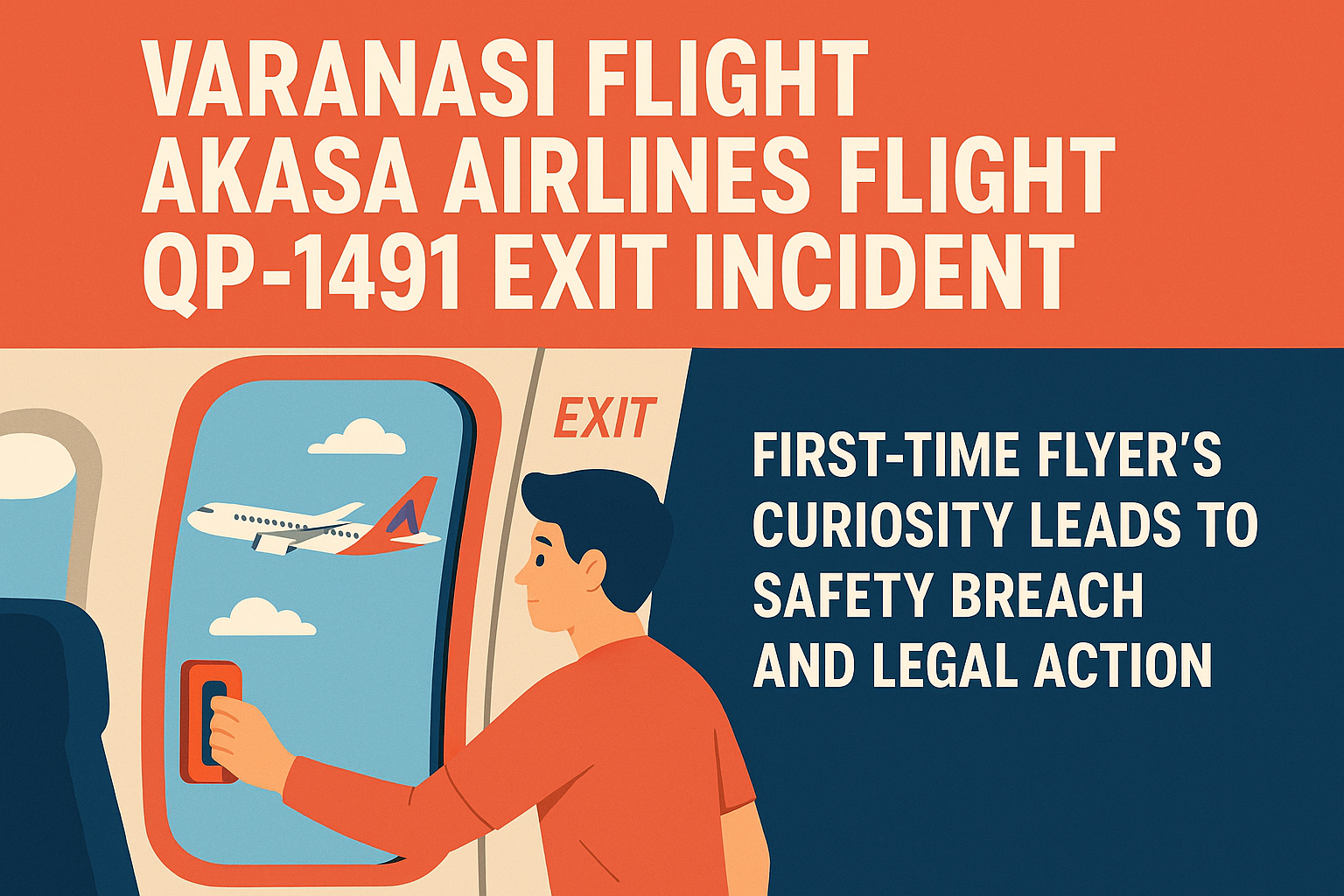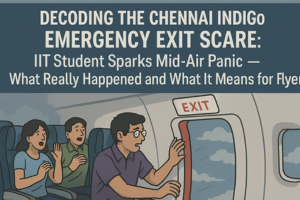On the evening of August 7, 2025, at Lal Bahadur Shastri International Airport in Varanasi, a first-time passenger on Akasa Airlines Flight QP-1491 to Bengaluru opened the cover of the emergency exit handle while the aircraft was positioned on the runway. This single act caused an immediate halt to takeoff preparations, triggered emergency protocols, and delayed the flight by one hour. No injuries occurred, but the disruption led to police involvement and legal charges. The case highlights the critical importance of passenger awareness and operational vigilance in aviation safety.
A curious but uninformed passenger disrupted flight safety in Varanasi, leading to delays and legal action, revealing urgent gaps in passenger education and highlighting the importance of strict airline safety enforcement.
WHO
- Ajay Tiwari, aged 32, works as a boom-lift operator at a cement factory in Karur, Tamil Nadu, and is a resident of Lambhua in Sultanpur district.
- This was his first flight experience. He was seated in seat 16A, adjacent to the emergency exit.
- Witnesses reported that he was observed “acting strangely” before removing the cover of the emergency exit handle.
- A cabin crew member spotted the act and immediately alerted the pilot, who then followed security procedures.
- Airport authorities and Phulpur police were involved after Akasa Airlines filed a formal complaint from its Delhi office.
WHAT
- Tiwari opened the emergency exit handle cover while the aircraft was on the runway preparing for takeoff.
- While the door itself was not opened, the action triggered safety concerns that required a full inspection before resuming operations.
- All passengers were deplaned for security checks, delaying the flight by around one hour.
WHEN
- The incident occurred at 7:55 PM on Thursday, August 7, 2025.
- The aircraft was already aligned for takeoff on the runway when the cover was opened.
- After about an hour of inspections and passenger re-boarding, the flight eventually took off for Bengaluru.
WHERE
- Lal Bahadur Shastri International Airport, Varanasi, Uttar Pradesh.
- The airport is undergoing capacity expansion as part of the Ministry of Civil Aviation’s infrastructure plans, although these developments are unrelated to the cause of this particular incident.
WHY
- Tiwari told police he opened the cover out of curiosity and to “read how the emergency exit works”.
- Being a first-time flyer, he did not fully understand that tampering with emergency equipment, even without opening it, can cause operational delays and legal consequences.
- Aviation safety experts note that while emergency exits are designed with protective covers and require effort to operate, opening them without authorization compromises the chain of safety.
HOW
- The cabin crew member observed the act in real time and immediately informed the pilot.
- The pilot returned the aircraft to the apron, where all passengers were offloaded and security personnel conducted a safety inspection.
- After the inspection confirmed there was no physical damage or risk, passengers were re-boarded and the flight departed.
- Tiwari was handed over to Phulpur police and booked under Section 125 of the Bharatiya Nyaya Sanhita.
Legal Context: Section 125, Bharatiya Nyaya Sanhita, 2023
- This section penalizes rash or negligent acts that endanger human life or safety, even if no injury occurs.
- Punishments include:
- No injury: Up to 3 months imprisonment or fine up to ₹2,500, or both.
- Injury caused: Up to 6 months or fine up to ₹5,000, or both.
- Grievous injury caused: Up to 3 years imprisonment or fine up to ₹10,000, or both.
- The offense is bailable and generally non-cognizable, meaning a warrant is typically required for arrest.
Broader Context and Comparisons
- A similar case in January 2025 involved an IndiGo passenger in Jodhpur who opened the flap covering an emergency exit handle just minutes before takeoff. The flight was delayed and the passenger was removed before departure.
- Internationally, some airlines in countries like Japan and Singapore use animated safety videos and mandatory first-time flyer orientations to reduce such incidents.
Solutions and Preventive Measures
Passenger Awareness Campaigns
Airlines should use visual infographics during boarding to explain that emergency exit covers should not be touched unless instructed by crew.First-Time Flyer Support
Introduce an optional pre-flight briefing for passengers who indicate they are flying for the first time.Crew Vigilance
Increase monitoring of passengers in exit rows, especially if they appear unfamiliar with aircraft safety features.Design Enhancements
Place bold warning labels directly on emergency exit handle covers to discourage unnecessary contact.Legal Education
Inform passengers that tampering with safety systems is a punishable offense under national law.
Conclusion and Call to Action
The Varanasi Akasa Airlines incident is a clear reminder that safety in aviation depends on both technical safeguards and human behavior. While Ajay Tiwari’s actions may have been driven by curiosity, they disrupted operations, caused delays, and triggered legal action. Preventing such incidents requires proactive passenger education, consistent enforcement of safety protocols, and better support for first-time travelers.
Call to Action:
If you are a frequent flyer, help educate new travelers in your circle. Share official safety resources, and encourage them to listen carefully to crew briefings. Safety is a shared responsibility, and every passenger plays a role in keeping the skies secure.



